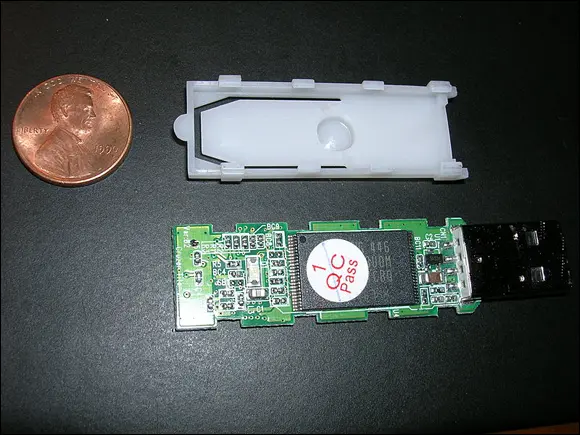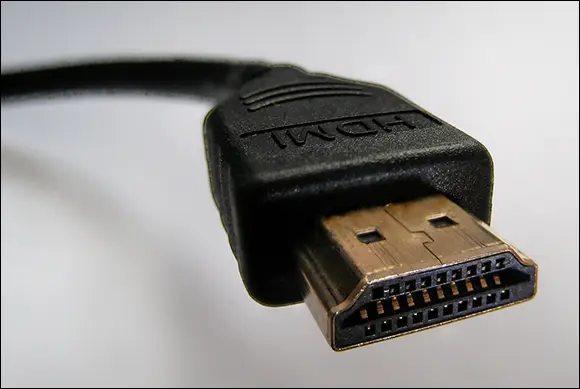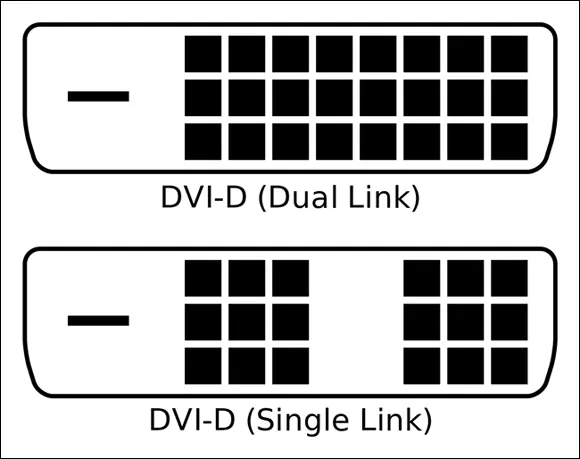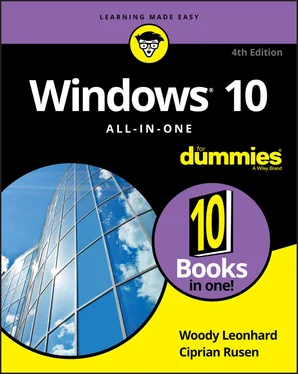USB drive or key drive: Treat it like it’s a lollipop: It's half the size of a pack of gum and able to hold an entire PowerPoint presentation or two or six, plus a few full-length movies. Flash memory (also known as a jump drive, thumb drive, or memory stick) should be your first choice for external storage space or for copying files between computers. (See Figure 1-9.) You can even use USB drives on many DVD players and TV set-top boxes.Pop one of these guys in a USB slot, and suddenly Windows 10 knows it has another drive — except that this one’s fast, portable, and incredibly easy to use. It's okay to go for the cheapest flash drives you can find. Some of the features on fancy USB drives are not useful to many users.

Source: Nrbelex, Wikimedia
FIGURE 1-9:The inside of a USB drive.
SOLID-STATE DRIVES HAVE PROBLEMS, TOO
Although I love my SSD system drives and would never go back to rotating hard disk drives (HDDs), SSDs aren’t perfect.
First, they don’t have any moving parts, and it looks like they’re more reliable than HDDs. But when an HDD starts to go belly up, you can usually tell: whirring and gnashing, whining and groaning. Expiring SSDs don’t give off any advanced warning signals. Or at least sounds.
When an HDD dies, you can frequently get the data back, although it can be expensive and time-consuming. When an SSD goes, you rarely get a second chance.
SSDs must take care of lots of internal bookkeeping, both for trimming unused space and for load balancing to guarantee uniform wear patterns. SSDs slow down after you’ve used them for a few months, or years. The speed decrease is usually associated with the bookkeeping programs kicking in over time.
Finally, the SSD’s own software has to be ultra-reliable. SSDs don’t lay down tracks sequentially like HDDs. They hopscotch all over the place, and the firmware inside the SSD needs to keep up.
 What about USB 3? If you have a hard drive that sits outside of your computer — an external drive — or a USB drive, it’ll run faster if it’s designed for USB 3 and attached to a USB 3 connector. Expect performance with USB 3 that’s three to five times as fast as USB 2. For most other outside devices, USB 3 is overkill, and USB 2 works just as well.
What about USB 3? If you have a hard drive that sits outside of your computer — an external drive — or a USB drive, it’ll run faster if it’s designed for USB 3 and attached to a USB 3 connector. Expect performance with USB 3 that’s three to five times as fast as USB 2. For most other outside devices, USB 3 is overkill, and USB 2 works just as well.
This list is by no means definitive: New storage options come out every day.
Your PC connects to the outside world by using a bewildering variety of cables and connectors. I describe the most common in this list:
USB (Universal Serial Bus) cable: This cable has a flat connector that plugs in to your PC, known as USB A (see Figure 1-10). The other end is sometimes shaped like a D (called USB B ), but smaller devices have tiny terminators (usually called USB mini and USB micro, each of which can have two different shapes).Source: Amazon Basics FIGURE 1-10:The most common USB A, B, C, mini, and micro USB cables. USB 2 connectors work with any device, but hardware — such as a hard drive — that uses USB 3 will be much faster if you use a USB 3 cable and plug it into the back of your computer in a USB 3 port. USB 2 works with USB 3 devices, but you won’t get the additional speed. Note that not all PCs, especially older ones, have USB 3 ports.USB-C is a special kind of USB connection that supports amazingly fast data transmission and high levels of power. You know when you have USB-C because it’s impossible to insert the plug upside-down — both sides work equally well. It’s becoming the go-to choice for connecting peripherals and, in some cases, power supplies. USB is the connector of choice for just about any kind of hardware — printer, scanner, smartphone, digital camera, portable hard drive, and even the mouse. Apple’s iPhones and iPads use a USB connector on one side — to plug in to your computers — but the other side is Thunderbolt (common on Apple devices, not so common on Windows PCs), and doesn’t look or act like any other connector.If you run out of USB connections on the back of your PC, get a USB hub with a separate power supply and plug away.
LAN cable: Also known as a CAT-5, CAT-6, or RJ-45 cable, it’s the most common kind of network connector. It looks like an overweight telephone plug (see Figure 1-11). One end plugs in to your PC, typically into a network interface card (or NIC, pronounced “nick”), a network connector on the motherboard. The other end plugs in to your wireless router (see Figure 1-12) or switch or into a cable modem, DSL box, router, or other Internet connection-sharing device.
Keyboard and mouse cable: Most mice and keyboards (even cordless mice and keyboards) come with USB connectors.Source: David Monniaux, Wikimedia FIGURE 1-11:RJ-45 Ethernet LAN connector. FIGURE 1-12:The back of a wireless router.
Bluetooth is a short-distance wireless connection. Once upon a time, Bluetooth was very finicky and hard to set up. Since the recent adoption of solid standards, Bluetooth’s become quite useful. It's now used for connecting all kinds of accessories, including speakers, headsets, mice, and keyboards.
DVI-D and HDMI connectors: Although older monitors still use legacy, 15-pin, HD15 VGA connectors, most monitors and video cards now use the small HDMI connector (see Figure 1-13), which transmits both audio and video over one cable. Some older monitors don’t support HDMI but do take a DVI-D digital cable (see Figure 1-14). Newer, premium monitors take advantage of the DisplayPort, which can transmit even more data than HDMI. Some really old monitors still use the ancient 15-pin VGA connector, the one shaped like a D. Avoid VGA if you can. Old-fashioned serial (9-pin) and parallel (25-pin) cables and Centronics printer cables are growing as scarce as hen’s teeth. Hey, the hen doesn’t need them, either.

Source: D-Kuru, Wikimedia
FIGURE 1-13:HDMI has replaced the old VGA and DVI-D video adapters.

Source: Hungry Charlie, Wikimedia
FIGURE 1-14:Two different kinds of DVI-D cables — they work well, but don’t carry audio.
Futzing with video, sound, and multitudinous media
Unless you’re using a cheap laptop or a tablet, chances are fairly good that you’re running Windows 10 on a PC with at least a little oomph in the audio department. In the simplest case, you have to be concerned about four specific sound jacks (or groups of sound jacks) because each one does something different. Your machine may not have all four (are you feeling inadequate yet?), or it may look like a patch board at a Slayer concert, but the basics are still the same.
Here’s how the four key jacks are usually marked, although sometimes you must root around in the documentation to find the details (see Figure 1-15):
Line In: This stereo input jack is usually blue. It feeds a stereo audio signal — generally from an amplified source — into the PC. Use this jack to receive audio output into your computer from an iPad, cable box, TV set, radio, CD player, electric guitar, or other audio-generating box. FIGURE 1-15:The audio jacks on the back of a desktop computer.
Читать дальше


 What about USB 3? If you have a hard drive that sits outside of your computer — an external drive — or a USB drive, it’ll run faster if it’s designed for USB 3 and attached to a USB 3 connector. Expect performance with USB 3 that’s three to five times as fast as USB 2. For most other outside devices, USB 3 is overkill, and USB 2 works just as well.
What about USB 3? If you have a hard drive that sits outside of your computer — an external drive — or a USB drive, it’ll run faster if it’s designed for USB 3 and attached to a USB 3 connector. Expect performance with USB 3 that’s three to five times as fast as USB 2. For most other outside devices, USB 3 is overkill, and USB 2 works just as well.












